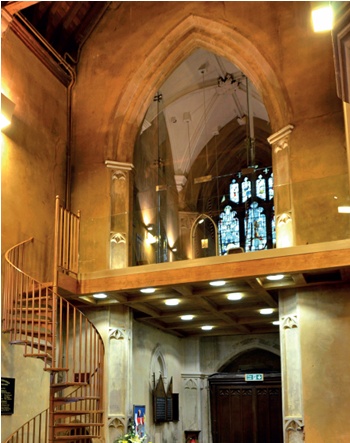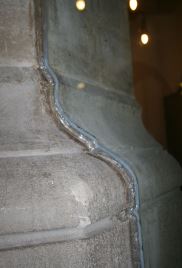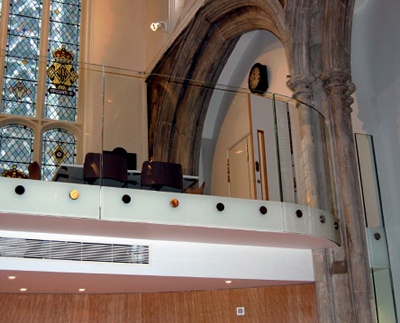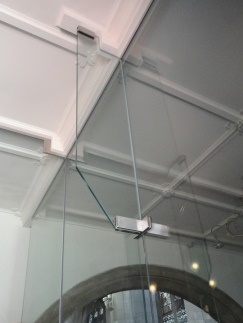Structural Glass for Historic Churches
Peter Hazeldean
 |
|
| A new glass balustrade at St Peter’s Church, Dunchurch, Warwickshire (All photos: Ion Glass) |
Many of Britain’s most inspiring churches are centuries old and while much of their charm lies in their historic architecture and materials, it’s important that the needs of modern congregations aren’t overlooked in favour of zealously preserving them in the time-warp of a previous century. Too many historic churches have become redundant shells in recent decades, and sympathetic adaptation is often key to their survival, enabling wider use by the community and the congregation itself.
Common problems include open draughty spaces that are impossible to heat; a lack of contained spaces to hold private meetings; fire protection and security issues around entrance doors; the need to introduce an acoustic barrier; or insufficient space for a thriving congregation.
While ongoing maintenance and conservation of the existing building are obviously important, the problem of how to update the church to meet 21st-century needs and standards without losing the magnificence of the existing architecture can prove a bigger challenge.
Provided it is correctly installed, structural glass is robust, durable and easy to maintain and will meet a wide scope of contemporary requirements with minimal aesthetic impact. Creating new spaces with glass will still permit natural light to illuminate the interior (especially important where stained glass windows are a prominent feature) while retaining heat and sound. Use of architectural glass opens up exciting opportunities to make significant changes to the functionality of the space without obscuring or damaging historic church fabric.
ACCURATE MEASUREMENTS ARE CRITICAL
Measuring the space is of particular importance when working in historic buildings because the stonework was hewn by hand. Arches that appear to be perfectly regular often prove to be substantially asymmetrical when surveyed using a laser distance measurer.
Fitting glass perfectly around stone corbels and carvings requires additional precise detailing and the use of a contour gauge (a comb-like device with sliding metal teeth) will record every nuance of the stonework to achieve the optimum result. Each panel of glass must be manufactured to order and accuracy in specification is critical. Glass industry standard tolerance in manufacture varies depending on the size of the panel but a close fit to the original stonework can be achieved by a glass specialist with experience in recording intricate and irregular surfaces.
CREATING SPACES WITH GLASS
Whether it’s a place where younger children can be cared for during Sunday services to allow their parents to worship without distraction, or a private area for discussion or counselling, the addition of a meeting room in a church creates the potential for new and extended uses.
Holy Trinity Church is just off Sloane Square in the heart of fashionable Chelsea. Its tight urban site meant that the church’s requirement for meeting rooms had to be met within the church – there was no opportunity to expand externally. Built in the late 1800s, Holy Trinity has been described as ‘the cathedral of the Arts and Crafts Movement’ and it contains treasures by some of the leaders of the movement, including magnificent stained glass by Edward Burne-Jones and Christopher Whall.
 |
||
| Above left: Precision detailing at St Clement’s Church, Hastings and, above right, the use of highly accurate measurement and cutting tools allows a close fit where structural glass elements need to follow the contours of the original fabric. | ||
An area under the original gallery on either side of the main entrance to the church had been used for informal meetings and storage but offered no privacy. Plans were drawn up to create two rooms constructed from structural glass which would allow an unhindered view of the nave.
To reduce noise transmission, the screens were fixed into channels in the floor and the ceiling above and stepped back from the columns, creating a continuous wall of glass without any gaps. The use of acoustic glass, which is laminated with an acoustic interlayer, further reduced both transmitted and reflected sound, contributing to a quiet and private environment.
Due to the height of the screen it was necessary to fit stabilising fins on the panels (facing page, top right) which were also manufactured from glass, ensuring there was nothing to interfere with the minimal appearance of the structure.
Moving an original metal screen from the rear of the church to the front of the new meeting rooms retained the style of the Arts and Crafts movement, combined with a motif applied to the glass that replicated the one on the screen.
MINIMISING HEAT LOSS
Heating the church of St Nicolas at Great Bookham had become a significant drain on resources. The church, which dates back to the 11th century, is an archetypical village church that had evolved over the centuries but had not seen any significant improvements for many years.
The combination of heat loss up the ancient (and little used) west tower and draughts from the wooden doors meant that the congregation had become used to feeling the chill in winter.
Ion Glass was engaged to install a screen across the width of the nave, combined with a glass door to sit inside the existing wooden entrance door.
Keeping the visual impact of the screen to the absolute minimum involved a technically difficult construction using vertical glass fins to stabilise the multi-panel construction of the arch. The decision was taken to fix the panels of glass to the ancient stonework by using a series of stainless steel clamps in preference to a continuous metal channel. This approach minimised the impact on the ancient fabric of the walls and was less intrusive visually.
The glass door which is set into the screen is over a metre wide, allowing easy access for wheelchair users and for pall-bearers during funeral services. An impressive three metres in height, the door had to be fixed into an over-sized floor spring cut into the original stone floor, and bespoke fixings were manufactured to take the weight and provide lateral stability while at the same time offering minimal visual impact.
Use of a laser distance measurer and contour gauge ensured that the screen fits closely around the exact shape of every corbel and is sealed to minimise heat loss. The screen also minimises the acoustic intrusion of the bells during services. Because the external door in the west tower is now in regular use as the main access to the church, parishioners can also enjoy the full glory of the aisle, stained glass windows and altar as they enter the building.
 |
 |
|
| Above left: a curved balustrade St Andrew Undershaft in the City of London. Above right: Holy Trinity, Sloane Square, London: structural glass fins provide stability to a glass partition. | ||
GLASS BALUSTRADES
Incorporating a mezzanine floor or gallery area can significantly increase floor space while the addition of a glass balustrade lets light in and maximises the visibility of original features.
Various glass balustrade systems are available with a range of options regarding fixings. Choosing the right system for a particular church requires careful consideration of the relevant design aesthetic, construction and cost constraints. Both curved and straight glass panels can be incorporated and the panels can be cut to fit around stonework, out-of-true walls and arches. It is also possible to make the balustrade frameless, avoiding the visual distraction of a handrail.
The balustrade installed recently at St Andrew Undershaft in the City of London is constructed from 21.5mm toughened laminate glass, bolted to the substrate of the gallery floor using a bespoke system.
A single row of stainless steel bolts across the front edge of the gallery helps to create a clean, stylish finish while a white film applied directly to the glass masks the unfinished edge of the floor. With curved panels at either end it provides an elegant sweep of glass across the whole width of the gallery.
With no visible clamps, posts or handrail, the installation is deceptively simple but remains fully compliant with the relevant building regulations. The design ensures that people using the meeting space on the gallery floor have an uninterrupted view of the nave while the natural light provided by the magnificent stained glass windows is unimpeded.
Hurst College, an independent school in Sussex has a long-standing tradition of regular worship, conducted in a glorious chapel built in the late 1800s. The school has increased in size and no longer had enough room in the chapel for the regular whole-school service. The high Victorian ceilings, however, provided sufficient space to build an unobtrusive suspended gallery above the main chapel entrance.
The design included a channel-set glass balustrade around the gallery with straight panels and concealed fixings. The balustrade was finished with a polished steel handrail, in keeping with other glass installations in the school.
PROTECTING STAINED GLASS
| A spider fixing at St Andrew Undershaft |
Making structural changes to the body of a church can raise floor levels so that windows previously high above ground level become accessible and at risk of damage. One solution is to install a glass panel in front of the original window. A sensitive approach to design and installation is needed to ensure the surrounding stonework isn’t damaged while at the same time protecting the window and meeting current building specifications.
The new gallery floor at St Andrew Undershaft is reached via a new staircase that sits directly in front of the splendid stained glass windows and a barrier was essential for protection.
A series of individual glass panels was installed in front of the stone mullions using purpose-made stainless steel supports and spider fixings (right) to stand the glass off the stone and avoid any damage to the carved surface. The result is a stylish span of glass at the side of the stairs that highlights and protects the leaded windows without obscuring their intrinsic beauty or blocking natural light.
At St Peter’s Church in the village of Dunchurch, near Rugby a new bell-ringing platform in the church tower created a room at the same height as the stained glass window. An over-sized glass panel was manufactured to fit in a single span in front of the window with bespoke stainless steel fixings to hold the glass in place. The panel is unobtrusive but protects the window from users of the bell-ringing platform.
A CLEAR WELCOME
Installing glass doors, preferably in addition to rather than as a replacement for traditional wooden doors, provides a secure but welcoming entrance that meets a range of modern needs. Glass entrance screens make it easier to install alarms and security protection, and create a barrier against noise, traffic fumes and heat loss while allowing a clear view of the interior, welcoming people into the church.
Bespoke doors can be customised to reflect the spirit of the individual church: at St Peter’s in Dunchurch handles were manufactured to reflect the exact arch of the nave; other churches have opted for an applied glass motif to echo designs incorporated into the altar cloth or carved screens.
At St Andrew Undershaft where the church is primarily used as a centre for Bible studies, a pair of secure glass doors was fitted inside the existing wooden doors. The doors are set into a stone archway with fixed glass panels on either side and an arched glass over-panel, all of which had to be accurately shaped to the stone and fixed in place with stainless steel clamps. Detailed and accurate measurements were taken to ensure that the glass fits perfectly against the original stonework.
It is possible to avoid the need for a visually obtrusive lock in the middle of a glass entrance door by fitting electromagnetic locks at the top or bottom. At St Andrew Undershaft a stainless steel transom houses the upper pivot point for the pivot doors and acts as a fixing point for the electromagnetic locks, which are linked to the church alarm system.
Glass is a versatile material that opens up many possibilities, allowing historic churches to meet modern requirements with minimal impact on the original structure. To ensure that the completed project meets all design and installation criteria and is fully compliant with current regulations, it is important to use an experienced glass specialist from the outset.



